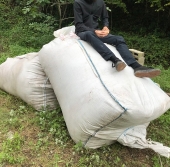posted 7 years ago
I like what you're doing already.
I have suggested in other places that perhaps a good idea would be to build regular miniature dams out of something water permeable like straw bales at intervals down the sand rivers, probably coinciding with swales, such that the overflow is diverted into them as the sections of river fill with sand.
These straw bale dams would trap sediment, slowly becoming less permeable. It occurs to me that perhaps you could use your cement bags filled with sand in a similar manner, but I suggest that you think on a natural succession to encourage structure to develop before the bags degrade. More on that in a sec.
If it were possible to create a sedimentation pond upriver in conjunction with the first of these barriers, it should be possible to take lots of the sand out of the water with it and the dams on their own.
From there, I would get vetiver or whatever else you can get to grow on the banks and over the sediment-filled dams to do so, dropping root systems down throughout the dams, holding them together and building a structural replacement for the straw with roots. Whatever you decide to grow, you might want to make sure that it can survive both flood and drought, and if it's native to the area, it might already be adapted to that. If it's a sandy soil pioneer, I wouldn't be surprised if the sediment dams catch the appropriate seed and start growing where they're needed on their own.
I was thinking about swales and sediment, and I think one option might be to dig the swales deeper, or if the swales are in the form of wide, shallow depressions on the land, the very centre of the swale might be trenched for drainage. Into this deeper trench, I would drop organic matter, preferably wood chips, but something that would both hold the soil open for drainage, and retain moisture itself after the water had gone, nurturing soil life through the drought.
I think that the best bet of your using that water is to separate the sand out. This sounds like a tricky bit of business. I mean, that sand will fill whatever you dig out for infiltration, right?
For that reason, I suggest that you think about how you can use the water to move the sand around for you. If you can somehow, through breaking up the flow of water or introducing turbulence with intentionally placed obstacles, direct the sand to areas of settlement, like your swales, or other landforms designed for the purpose, or to catchment areas that can be dug out when dry, you can move the sand to places where it will either be out of your way, or where it will augment the changes to the land you have made, continuing to encourage the action of water and sand to do what you want.
For instance, if most of the sand came on an initial flood, if you had water-permeable dams blocking off your swales, the initial mass of sand would be pushed downstream. It would settle against the upstream sides of the dams perpendicular to the flow of water, but as the sections filled with water, the swale dams, oriented parallel to the direction of flow, would allow water to seep through readily, but trap any remaining sediment so as to not fill your swales.
Let us know how it goes. Pictures would be much appreciated. Good luck, and keep us posted.
-CK
A human being should be able to change a diaper, plan an invasion, butcher a hog, conn a ship, design a building, write a sonnet, balance accounts, build a wall, set a bone, comfort the dying, take orders, give orders, cooperate, act alone, solve equations, analyze a new problem, pitch manure, program a computer, cook a tasty meal, fight efficiently, die gallantly. Specialization is for insects.
-Robert A. Heinlein





 3
3




















 1
1













 2
2






















